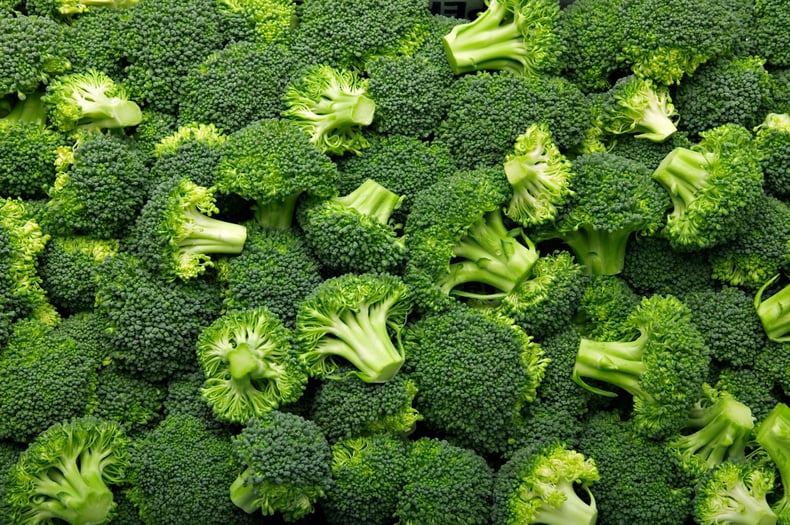Ideas for repurposing broccoli trim and overproduction

This post is part of a Leanpath culinary blog series looking at ideas for repurposing commonly overproduced menu items.
We encounter quite a lot of broccoli in foodservice operations’ waste data. Whether it be trim waste–i.e throwing away edible stalks–or overproduced cooked broccoli that is discarded, there are various innovative things kitchen teams can do to keep broccoli out of the bin and ensure its purchase value is retained.
Broccoli has several qualities that make it the ideal ingredient to repurpose. Its sustenance and good value relative to its weight make it the perfect yield increasing ingredient to add to dishes. Broccoli’s low calorie and high nutrition and vibrant color also make it a repurposing super food which is also quick to cook, further enhancing its repurposing potential.
Repurposing/utilizing stalks: Broccoli stalks can bulk out your dishes to increase yield as well as even being a central ingredient to a dish when prepped and dressed with care.
Broccoli Stalk Slaw: In the same way you would prep cabbage or carrots for a slaw, broccoli stalks can be passed through a processor or sliced thin by hand to form part of a slaw salad. The earthy brassica flavor of broccoli goes well with nuts like almonds and hazelnuts and also works well with South East Asian dressings that incorporate nuts or seed/nut oils. Marinating broccoli stalks in a dressing in advance will help to tenderize the product and enhance the final texture.
Broccoli Rice: Much in the same way cauliflower rice has become a popular low calorie alternative to starchy rice, Broccoli stalks can also be used in the same methodology of preparation. When using broccoli stalks, it is wise to peel off the very outer layer, leaving the more tender part of the ingredient for use.
Kimchi: Broccoli is certainly a good yield increasing ingredient to add to any zero waste kimchi being prepared onsite. Much like cabbage and onion, broccoli stalks are robust enough to maintain their crunch after long periods of time spent in fermentation.
Repurposing cooked broccoli is another great opportunity to avoid food waste. Whether blitzing and using as a color enhancer or maintaining its natural bulkiness to increase dish yield, there are a myriad of ways to get the maximum out of your overproduced broccoli.
Lasagnas, Bakes, and Pies: Broccoli famously goes well with stronger cheeses like stilton, parmesan or even mature cheddar. A bechamel sauce based broccoli and cheese pie, lasagna or bake is always a winner with a hungry diner. Topping and gratinating a bake with breadcrumbs, chopped nuts, garlic, herbs and cheese will work wonders with the flavor of the broccoli.
Broccoli Quiche/Frittata/Omelette: Incorporate chopped broccoli into a quiche filling with eggs, cheese, and seasonings. It makes for a delicious brunch or lunch option. Combining it with sliced potato can reduce the overall carb and calorie count of an omelette or frittata solely using potato or other carbohydrates.
Broccoli Stir-Fry: Broccoli is a great addition to a stir fry adding sustenance and texture. With whole broccoli, separate the stalks from the florets and slice the stalks thin so that both parts of the broccoli can cook/heat together in tandem. Broccoli will start to lose its beautiful color and texture and also nutritional content when overcooked.
Broccoli Salad: Broccoli florets and stalks can bulk up more robust salads and add a healthy vibrant green color. Cooked broccoli goes well with more filling salad ingredients like cous cous, chilled pasta or chickpeas. Again, thinly slicing the stalks and leaving the florets chunky will result in the best possible textures. How about adding broccoli into a Spanish inspired salad with chickpeas and a smoked paprika, garlic and red wine vinegar dressing.
Broccoli Fritters/Croquettes/Falafel: Combine chopped or blitzed broccoli with a batter made from flour, eggs, and seasonings to create broccoli fritters. Pan-fry them until they're crispy and serve with a dipping sauce. Using a starchy ingredient in place of egg like chickpeas, mash potato or a thick bechamel will help to bind the croquette/falafel and help to enable a good consistency and an end product that can be picked up by hand and dunked into a dipping sauce.
Broccoli Pesto/Hummus/Dips: Blitzed broccoli provides a vibrant green puree that can enhance and bulk out many different types of dips and sauces. If blitzed in with spinach or other iron rich leafy greens like kale, the color can be further enhanced. Adding in to your pesto, hummus and other dips from around the world is an easy, clever and delicious way to keep broccoli out of your bin.
Enhancing Sauces and Curries: Blitzed in the same way as above, broccoli can be added into sauces and curries where a bright green color is desirable. Adding into your pesto pasta for example or using to enhance an Indian Dal or Saag Aloo is a clever, healthy and delicious way to maximize your yield.
All of the above ideas can be adapted based on the specific ingredients and flavors available in your kitchen. Experiment with flavors and textures and get creative with your culinary creations, reducing food waste in the process.
Check out the other posts in this blog series: